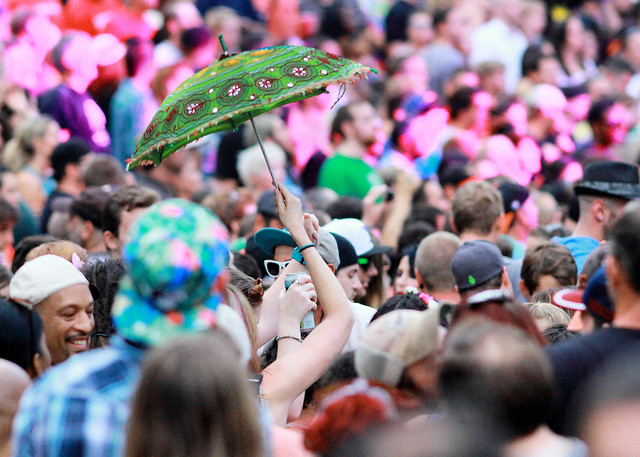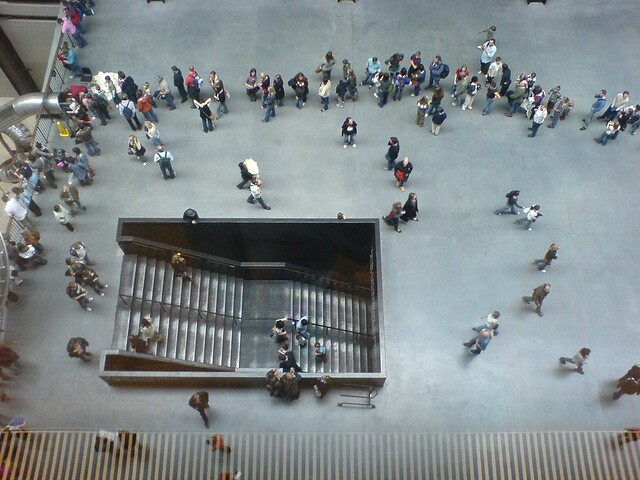Whether you’re chanting at a protest, partying at a concert, or cheering at a football game, there’s a special kind of excitement that comes from being in a crowd. Émile Durkheim called this “collective effervescence,” and today sociologists use this term to talk about the bubbly emotion that comes from being in the middle of the action.

One of the tricky parts of studying collective effervescence is figuring out what exactly supercharges these social interactions. Does it come from the simple fact that you’re in a crowd, or is it in the way people engage with each other when they get there? If we think about the morning commute or the line at the grocery store, most crowds seem pretty unpleasant and not so effervescent. Recent research published in Sociological Science by Lasse Suonperä Liebst sheds light on the answer with a super fun approach to data collection.

To track collective effervescence, a team of researchers showed up at The Roskilde Festival—one of Europe’s largest music festivals—to survey attendees about whether their camping experiences were “festive, noisy, hectic, boring, or calm.”
The survey was sampled by a team of 11 university students during the five warm-up days of the festival, which precede the scheduled music program. During this period, tens of thousands of visitors build tent camps and engage in extensive drinking and partying activities. As such, the festival offered a “natural laboratory” (Park 1939) to examine the factors underpinning the collective effervescence that prior studies have identified in this (Pedersen 2014) and similar festival contexts (Niekrenz 2014).
Lasse Suonperä Liebst – “Exploring the Sources of Collective Effervescence: A Multilevel Study.” Sociological Science.
The survey team also collected respondents’ gender, age, previous festival attendance, how much their camp sites were interacting with others, and how much they personally enjoyed the party atmosphere. Then, they used aerial photography to map out how dense the festival crowds were and how close each campsite was to the central stage.
With all this information collected, statistical models showed that individual preferences for partying did have a positive relationship the with reported level of collective effervescence at their campsite. However, the aerial measure of crowd density was a much stronger predictor of these reports—stronger than attendees’ own accounts of how often their camps were hanging out with others.
These results help us understand how collective effervescence happens, because they show how even just being near a crowd can “sweep people up” into a festive state. We often assume that crowds are stressful unless people choose to be in them or have positive, one-on-one interactions once inside. It is true that context matters—the grocery store queue probably won’t spark a party anytime soon—but this research shows the power of space and place for shaping our social lives.

Comments 31
will hennig — June 1, 2019
I am chronically alittle depressed. So how I lower it some is by walking my dog. As this city I am in now is now having a festival over to there we go. Be well all.
coca — February 24, 2020
Article with a deep knowledge and well-staged. I have visited your website. It is very interesting and impressive. Thanks for sharing with us such a great article. I want to come again. Please update.
vin lookup
Abraham — June 16, 2020
Normally people join these events to enjoy the moments and people are always excited about it. The career booster reviews are also working to control these events and enjoy it.
Maha — July 15, 2020
I rarely go in crowed. Going to crowded places causes a headache. I just watch all the matches on the TV...
acceleratedrecovery.com
wendy — September 17, 2020
I am in now is now having a festival over to there wNormally people join these events to enjoy the moments and people are always excited about it. e go. Be well all
sareh — September 19, 2020
Very Good If You Look For New Music See:
https://guitarmusics.com/songs/
amin — September 19, 2020
Very Nice If You Look For New Music See:
https://guitarmusics.com/songs/
Rose — September 26, 2020
Very unique research about human emotion. It is very interesting and i have read this information 2 to5 times and collect some basic human behavior emotion.I am much glad to read it.
https://www.iconsmktg.com/photography
Rose — September 26, 2020
Very unique research about human emotion. It is very interesting and i have read this information 2 to5 times and collect some basic human behavior emotion.I am much glad to read it.
real estate photography
jack — October 28, 2020
Who knew that I’d be so interested in a one-year-old’s birthday, but wow, you guys really went all out. There is clearly so much love and happiness within your family and that really warms my heart. This looks like the funnest party in the world to be at, and I’m so glad you guys got to enjoy yourselves as well and not stress too much!
jhon — December 9, 2020
In conclusion, it is perfectly up to you to definitely choose if you are wide open minded sufficient to discover info that will assist you get pleasure from your traveling experience. This post is suggested to give you information and facts to boost the conditions of your after that getaway. Make sure you keep in mind that travelling is supposed to be nice
aidin — January 26, 2021
Download the After Effects ready project for production and production and advertising teasers. You can make your own promotional video. Just do a little research on how to make TV commercial teasers, then you can create the most attractive advertising teaser by presenting creativity and practical ideas by After Effects. You can make the best professional teasers by downloading the After Effects project for free and attract the attention of all users. Your audience will definitely be surprised to see your promotional teaser video.
sportstototvcom — March 14, 2022
It’s going to be finish of mine day, but before end I am reading this impressive piece of writing to improve my knowledge.| https://www.sportstototv.com
casinosite777.info — May 19, 2022
that’s what I was looking for, what a information! We offer safe and trusted online site for gamer. click here: https://www.casinosite777.info
safecasinosite.net — May 19, 2022
Write more high-quality articles. I support you. We recommended to you our safest Online games. go here: https://www.safecasinosite.net
baccaratsite.biz — May 19, 2022
It is very well written, and your points are well-expressed. If anyone looking for safety playground for online gaming, Feel free to visit my site: https://www.baccaratsite.biz
sexy — May 20, 2022
was impressed by your writing. Your writing is impressive.. Keep sharing a quality article. https://www.casinositewiki.com
texasholdemsiteinfo — May 21, 2022
Thank you for your idea. You are such an incredible problem solver.
totosafedbcom — May 24, 2022
Thank you for sharing this useful article , and this design blog simple and user friendly regards. https://www.totosafedb.com
waffle wordle — October 21, 2022
Studying is important and good, but you should also make time to have fun. Why not put them together? Here's a game about letters that can help you both learn new words and feel less tired.
gray serena — October 21, 2022
The number of people who play games has grown. So that I can play this game to wind down at the end of a long day https://waffler.one/
Stumble guys — November 10, 2022
Stumble guys is a game inspired by the famous game fall guys. You will have to play the levels with many people.
totovi — December 5, 2022
I saw your writing without thinking because it was so touching. Thank you very much. I think I'll keep looking at your writing. I hope you continue to write good things in the future. Looking at your writing, I hope you have a good day. 메이저토토사이트
totoright — December 5, 2022
I will also motivate almost everyone to save this web page for the help they like to help their posted appearance. 토토사이트
Phuong — December 27, 2022
Great article and very meaningful to me. The wordle nyt in the article are easy to understand and have a scientific presentation to help readers easily understand all of its content.
FoodDoz — June 4, 2023
Thanks for the blog. http://www.fooddoz.com
FoodDoz — June 4, 2023
Thx http://www.fooddoz.com
Retro bowl — June 8, 2023
This is an intriguing subject. I came upon your website while conducting an unexpected Internet search Retro bowl.
Coby Brian — October 22, 2023
The concept of collective effervescence in crowds, as discussed by Émile Durkheim, highlights the exhilarating experience of being part of a lively gathering, whether it's at a protest, concert, or sporting event. However, what precisely fuels these social interactions remains a subject of inquiry. Recent research by Lasse Suonperä Liebst, featured in Sociological Science, offers a unique perspective on this question. While many crowds can be mundane or even unpleasant, the key lies in how people engage with each other within them. Understanding these dynamics can shed light on the electrifying nature of collective effervescence. For a change of pace, explore the captivating world of Selera Nusantara: Chef Story or dive into Download: PC/Windows to uncover exciting digital experiences.
Blondase — November 8, 2023
Great post, you can play game every day to fun, you can choose game geometry dash meltdown this is a fun game with many Rhythm challenge.
Civaget — April 18, 2024
Overall, I'm impressed with the functionality and usefulness of 오피 for discovering and researching businesses.